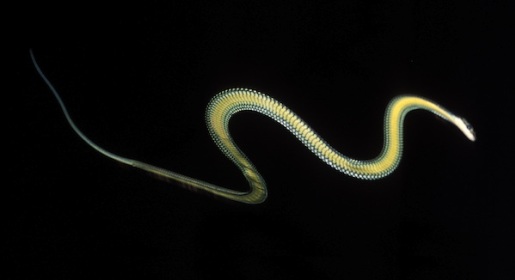
It’s one of the biggest secrets of the animal kingdom. There are five species of snakes in South and Southeast Asia (including the above paradise tree snake or Chrysopelea paradisi), or that are capable of flinging themselves down from the tops of trees to the forest below without shattering into a thousand pieces or taking any damage whatsoever. In fact, some of these snakes can glide up to 80 feet through the air, but how? Basically, the snake is able to turn its entire body into a wing to achieve flight.
“For any flier, you really need to know the basics: How fast is it going, what’s the shape of the flier, what is the shape of the wing. With this new study, we now really get insight into what the exact position of the body is as it’s in this really developed glide.” said Jake Socha of Virgina Tech, who presented his paper on the physics of snake flight to the American Physical Society Division of Fluid Dynamics. He added, “The whole snake itself is just one long wing. That wing is constantly reconfiguring, it’s constantly reforming and contorting… Parts of the body, depending on where they are in space, might be interacting with the wake from the front part of the body, and this might hurt or help or be neutral.”
So there you go, snakes fly without wings or renting airplanes because they are able to contort their bodies in midair to obtain maximum glide.
Tags: paradise tree snake, flying snakes, how snakes can fly, unusual animals, physics, fluid dynamics, Virginia Tech, Jake Socha, gliding snakes, how snakes can glide up to 80 feet, Chrysopelea paradisi, flying snakes, physics of how snakes can glide, weird animals, Southeast Asia, American Physical Society Division of Fluid Dynamics, weird science







